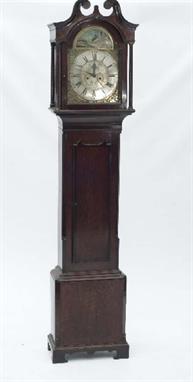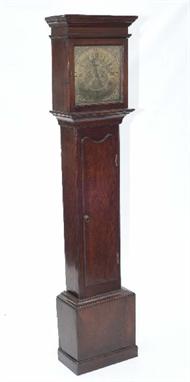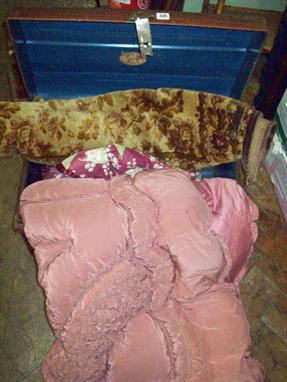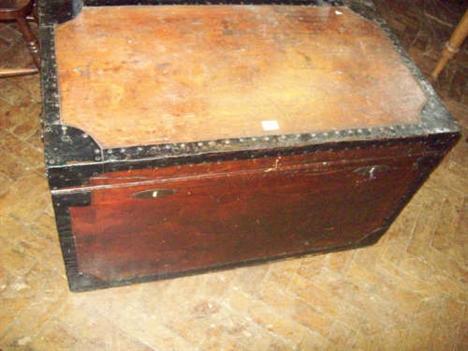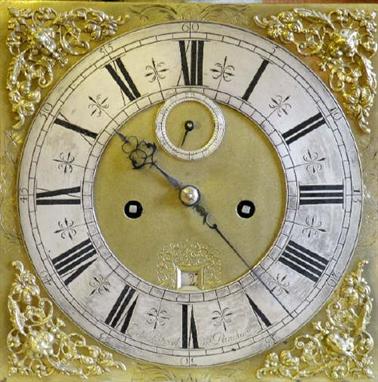A late 18th Century mahogany longcase clock by John Edgccumb (Edgecumbe) of Bristol, the 12ins arched painted dial with Roman and Arabic numerals, subsidiary seconds dial and date aperture, the arch showing phases of the moon to the eight day two train movement striking on a bell, contained in plain mahogany case with swept top and turned, fluted and brass stopped pillars to hood, arched trunk door, 88ins high (dial scratched, plinth reduced in height and case repolished).
We found 66892 price guide item(s) matching your search
There are 66892 lots that match your search criteria. Subscribe now to get instant access to the full price guide service.
Click here to subscribe- List
- Grid
-
66892 item(s)/page
A late 18th Century mahogany longcase clock by John Vidion of Feversham, the 12ins arched silvered dial with Roman and Arabic numerals, subsidiary seconds dial and date aperture, showing phases of the moon to the arch, to the eight day two train five pillar movement striking on a bell, contained in mahogany case with pagoda top, and turned, fluted and brass stopped pillars to hood, arched and moulded trunk door veneered in figured mahogany and flanked by fluted and brass stopped quarter columns, the base with applied astragal moulding and double plinth base, 90ins high Note : John Vidion recorded working as a Watchmaker in Faversham pre 1774- 1801.
A late 17th/early 18th Century Dutch oak and marquetry longcase clock by Bernard Van der Cloesen of The Hague, the 12ins square brass dial with wide silvered chapter ring with Roman and Arabic numerals, the matted dial centre with turned winding holes showing phases of the moon and calendar work and with cast brass cherub's head spandrels to the eight day two train five pillar movement with alarum, Dutch striking on two bells, contained in oak and marquetry case inlaid with birds, ribbon and trailing leaf and floral motifs, the hood with stepped pagoda top and plain turned pillars to hood, the trunk door with oval lentical, on plinth base, 90ins high, Note : Bernard van der Cloesen (ante 1650-1736) was born in Emmerik and having been married in the Hague, became a citizen of the city in 1688. With the establishment of the Clockmaker's Guild in 1688 he became Warden and later Master. In 1699 succeeded Lubbertus van der Burgh as City Clockmaker for the Hague, being succeeded by one his sons, also Bernard, in 1735. In 1694 van der Cloesen made Christian Huygens last clock for measuring longitude at sea. See Dr. R. Plomp, Spring Driven Dutch Pendulum Clocks 1657-1710 Schiedam 1979 for illustrations.
A Uniform to Lieutenant Colonel Charles Meredith Inigo Jones, Royal Artillery, comprising Blues tunic and trousers, No.2 Service tunic and trousers, a pair of black leather hob nail boots and a military sleeping bag; together with his dog tags, three portrait photographs and a copy of his CV, RA buttons, shoulder boards and collar badges, small paper flags, two pieces of Trench Art comprising an ashtray and a shell case tobacco jar and cover inscribed BALKANS 1917, etc, all contained in black metal trunk **Charles Meredith Inigo Jones was born 12-12- 1912.
A Sidcot Suit, in khaki, with zip side-front fastening, buttoned overlapping collar and flies, and ankle to calf zips, the inside with stencilled arrow and label Size No.1; a pair of Irvin Flying Trousers, each leg zipped from waist to ankle, with a large patch pocket, with the braces and Air Ministry label Size 36 No.B25961/38 1938; an Irvin Type Sheepskin Lined Leather Flying Jacket, with front zip fastening and two patch pockets, with indecipherable label; a Pair of M VII Training Goggles, in original box, all contained in a tin trunk
An oak and mahogany cased, eight-day longcase clock, the broken swan neck pediment above an arched glazed panel door flanked by two turned free standing columns, the trunk door flanked by quarter columns above a planked base on ogee bracket feet, the painted dial with haymaking scene to the arch subsidiary seconds dial and date aperture, indistinctly signed W Hann Gloster, the dial 30.5cm (12")
A LARGE 19TH CENTURY PINE WALL CLOCK having an arched moulded cornice above the arched glazed hood door flanked by turned columns, the shaped trunk door over the tapering base, the chapter ring with Roman hours and Arabic minute and date dials enclosing the maker's name, Rob Hall, Owestry . 145cm
A VICTORIAN OAK AND MAHOGANY 30-HOUR LONG CASE CLOCK by James Squires of Penrith, having a broken swan neck pediment with brass disk terminals flanking a brass ball and eagle finial, the arched glazed door flanked by turned columns, arch of the dial painted with a huntsman on horseback and numerous hounds chasing a distant fox, the chapter ring with Roman hours framing the maker's name and crescent form date aperture, all within spandrels painted with bounding hounds, the cross banded pointed arch trunk door over a plain cross-banded base and plinth. 216cm
A 19TH CENTURY OAK AND MAHOGANY 30-HOUR LONG CASE CLOCK, George Wilson, Appleby, having a broken swan neck pediment with brass disk terminals above an arched glazed hood door and turned columns, the cross banded trunk door with small panel below raised on a plain base, the arch of the dial painted with a water mill scene, the chapter ring with Roman hours framing the makers name, subsidiary faux seconds and date dials, all framed by painted spandrels depicting game hunting scenes, sold with weight and pendulum. 212cm
A fine quality and rare mid 18th century crossbanded walnut veneered and herringbone inlaid cased striking eight day longcase clock with spherical ball moonface movement by Thomas Ogden of Halifax, circa 1750, the 35cm arched brass dial applied with dolphin, mask and scrolling foliage spandrels, the dial with subsidiary seconds dial, date aperture and twin winding holes, the elegant trunk having a shaped door with glazed lenticle, the crossbanded base raised on a moulded outswept plinth and short bracket feet, with twin weights and pendulum, height 240cm (Illustrated)
A 19th Century oak eight day long case clock, the arched painted Arabic dial with subsidiary seconds and date dials, the arch and spandrels decorated fishing and castle ruin scenes, inscribed Robson, Chester le St., the flat top hood with turned columns above a canted trunk with mahogany crossbanded door and base raised on bracket feet, 86" high.
THOMAS SHAW, LANCASTER, A FIGURED OAK AND MAHOGANY CROSSBANDED LANCASHIRE LONGCASE CLOCK, with long trunk door, the hood with swan neck pediment and freestanding tapered cylindrical brass capped pillars, 33cm brass arched dial inscribed "SIC TEMPUS FUGIT" in the arch, and signed in reserve above "6", centre sweep date pointer, four pillar weight driven eight day movement with rack strike on a bell. 2.25m Note: T.Shaw is recorded as working 1776-1795.
TIMOTHY ROBERTS, OTLEY, A LATE 18th CENTURY YORKSHIRE OAK LONGCASE CLOCK, the rich oak case with long trunk door and flat moulded hood styled without pillars, 30.5cm square brass dial with superior engraving, dummy winding holes and seconds with date wheel (connected), thirty hour pull-up wind movement with four pillars and unusual skeletonised plates, outside countwheel strike on a bell. 2.00m
George III mahogany longcase clock, the arch shaped dial having a moulded cornice and reeded columns, trunk with long door, arch shaped brass dial with cast spandrels, centre with engraved bird decoration, chapter ring with Roman numerals, subsidiary seconds dial and calendar aperture, signed John Mercer, Hythe, eight day striking movement, 204cm high
A Staffordshire Sailor toby jug circa 1800, the smiling fellow modelled seated upon russet glazed trunk and handle, attired in green frock coat, white spotted red waistcoat and lemon breeches, holding a frothing beaker and a florally painted jug, on green and brown washed base with further manganese and turquoise striped base, (later painted frock coat) 30cm high
A walnut eight day longcase clock, 18th century, the 12 ¥ inch arched brass and silvered dial with convex disc to the arch signed 'Alexander Barclay, Cupa', with centred subsidiary seconds dial and date aperture within a ring of Roman numerals and outer ring of Arabic numerals, with pierced scrolling leaf corner spandrels, the restored five pillar movement striking on a single bell, the caddy top hood with arched glazed door flanked by three quarter turned front corner hood pilasters over a long, arched, feather banded trunk door on a crossbanded box base (lacking feet), 218cm high
A George III oak eight day longcase clock, the 11 inch square brass dial with silver chapter ring signed 'Edward Patrick at Parshore', with centred subsidiary seconds dial and date aperture, the chapter ring with Roman and Arabic numerals, within cherub moulded pierced corner spandrels, the restored four pillar movement with anchor escapement striking on a single bell, the hood with quartrefoil blind fret frieze over a square glazed door between turned front corner hood pilasters (pilasters possibly later), over a narrow ogee moulded crossbanded long trunk door, between short quarter fluted front corner trunk pilasters on a plain box base with later skirting plinth, 206cm high
AN OAK EIGHT DAY LONGCASE CLOCK, signed Humphrey Hadley, Birmingham, the four pillar movement with anchor escapement and rack striking on a bell, 12" arched brass dial with silvered chapter ring and matted centre chased with a crown and foliage, calendar aperture and secondary dials, the arch with penny moonphase, the case with stepped flat top, dentil moulded cornice and blind fret frieze on turned columns, canted trunk with arched door, on panel base, 82 1/2" high
A mahogany longcase clock, with a three train musical movement striking on a peel of eight bells and a gong with a 12 inch brass arched dial with silvered chapter ring and subsidiary seconds dial, the arch with a painted moon phase, the pagoda hood with a central pierced blind fret panel having ball and eagle brass finials above an arched trunk door with fluted canted corners, the base on splay bracket feet, 91in (231cm) h. Movement, dial and case associated, case with warped trunk door and cracks to veneer, back left foot part missing.
A George III oak longcase clock, with an eight day five pillar movement striking on a bell, to a 12 inch brass arched dial with subsidiary seconds dial and engraved foliage, inscribed 'Edwd Blowers, BECCLES', above a pierced date aperture, the arch with a strike/silent dial, the hood with tapering pilasters and an arched trunk door with applied moulding, the base on bracket feet, 82in (208.5cm) h. Old restoration.
A George III oak longcase clock, with an eight day movement striking on a bell and a 13 inch brass arched dial with subsidiary seconds dial and date aperture engraved a boat, issuing foliage and birds, with a silver chapter ring, the moon dial painted rural scenes and inscribed 'JOSEPH STANCLIFFE, BARKISLAND', the hood with broken swan neck pediments and turned columns above a shaped top trunk door with quarter pilasters to a panelled base on bracket feet, 88in (223.5cm) h.
An oak longcase clock, with an eight day movement striking on a bell and with a 10 inch square brass dial having a silvered chapter ring inscribed 'Jno Ettry, Horton', the hood with a moulded cornice above a plain frieze and turned pilasters having a rectangular trunk door on bracket feet, 80in (203cm) h.
A late George III mahogany longcase clock, with an eight day movement striking on a bell and a 12 inch painted dial with subsidiary seconds dial, inscribed 'COX, DEVIZES', the arch with a moon phase painted a rural landscape and a view to sea, the case with a broken swan neck pediment and ball and spire brass finial above a dental arch on corinthian column capped columns, the rectangular trunk door with stringing and crossbanding, the base on backet feet, 93.5in (237.5cm) h.
Daniel Delander. A George I walnut and marquetry longcase clock, with a month going movement having five ring turned pillars and a 12 inch square brass dial with subsidiary seconds dial and pierced date aperture, the silvered chapter ring inscribed 'Dan. Delander. London.', the walnut and marquetry case with a moulded cornice and a blind fret frieze, the door with spiral turned pilasters, above a rectangular cushion moulded trunk door with lenticle decorated flowering urns and figures, with plain walnut sides having stringing to a conforming base and plinth, 83.5in (212cm) h. A pendulum and two weights. Restoration to the case.
A mid-20th Century Oak cased Clock, modelled in the form of a small Longcase with arched hood, long plain panelled trunk, to a plinth base, and ogee bracket feet, with spun brass bezel enclosing a 6 ½" silvered Roman dial with blued steel pierced hands, and spring driven movement with anchor escapement, strike on a gong, height 52"
A last quarter of the 18th Century Oak cased 30 hour Long Case Clock, Val Hanbury of Watford (Northants), the associated case with moulded overhanging cornice to a glazed door and ogee throat, with long trunk drawer and reduced plinth base, to a 10" square brass dial with applied shell and "C" scroll spandrels, enclosing a Roman chapter ring with fleur-de-lys half-hour markers and inside track, to an engraved centre with single pierced steel hand, to a movement with plates united by four pillars, and back mounted count wheel, with anchor escapement, strike on a bell, height 75"
A second quarter of the 19th Century Mahogany cased 8 day Long Case Clock, Lasseter of Stenning, the arched hood with overhanging cornice to reeded and gilt metal mounted capitals, to an ogee throat, and long arched trunk door, to a panelled plinth base with integral bracket feet, to a signed 12 ½" third period arched painted dial, surmounted with a rocking ship automaton to the arch, over fruit and shell painted spandrels enclosing a Roman chapter ring, and signed centre, with subsidiary seconds and further date subsidiary, to a Walker and Hughes false plate, and movement with plates united by four knopped pillars and anchor escapement, strike on a bell, height 83"
-
66892 item(s)/page



















